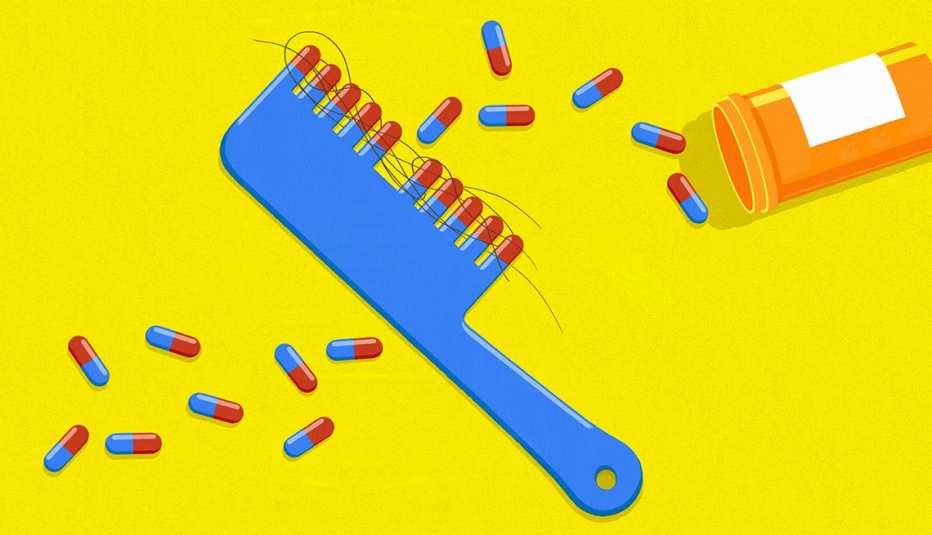AARP Hearing Center


The patient was depressed. She had kidney disease, endured regular dialysis and had undergone an aggressive medical regimen after doctors discovered blood clots. But that wasn’t what dimmed the 49-year-old’s spirits.
“My hair is falling out,” she lamented.
Her doctors suspected the cause. She had been prescribed warfarin, an anticoagulation drug (a type of blood thinner), to deal with her clotting issue. Within three weeks of switching to an alternative drug, apixaban, her hair stopped falling out — and eventually, it grew back.
Like turning gray, hair loss can be a natural part of aging. But alopecia, the medical term for hair loss, is a complex condition with many variations, from slow-progressing balding (referred to as male- or female-pattern hair loss) to more rapid and patchy loss (alopecia areata is a common form). Genetics, hormonal changes, inflammation and even certain diseases can trigger temporary or permanent hair loss. Prescription drugs may also trigger excessive and sudden shedding.
10 Types of Meds That Can Harm Your Hair
Ask your doctor about these drugs, which can cause hair loss in some patients.
1. Anticoagulants
- Heparin
- Warfarin (Coumadin, Panwarfin, Sofarin)
2. Antidepressants, mood stabilizers, bipolar disorder medications
- Citalopram (Celexa)
- Divalproex sodium (Depakote)
- Fluoxetine (Prozac)
- Lithium
- Paroxetine (Paxil)
- Sertraline (Zoloft)
- Valproic acid
3. Antimicrobial tuberculosis drugs
- Isoniazid
4. Arthritis, inflammation drugs
- Etanercept (Enbrel)
- Leflunomide (Arava)
- Methotrexate (Rheumatrex, Trexall)
5. Blood pressure meds
- ACE inhibitors
- Beta-blockers
6. Chemotherapy drugs
- Checkpoint inhibitors: avelumab (Bavencio), ipilimumab (Yervoy), nivolumab (Opdivo), pembrolizumab (Keytruda)
- Cyclophosphamide (Cytoxan)
- Daunorubicin (Cerubidine)
- Docetaxel (Taxotere)
- Doxorubicin (Adriamycin)
- Epirubicin (Ellence)
- Erlotinib (Tarceva)
- Etoposide (VePesid)
- Gefitinib (Iressa)
- Ifosfamide (Ifex)
- Irinotecan (Camptosar)
- Nilotinib (Tasigna)
- Paclitaxel (Taxol)
- Topotecan (Hycamtin)
- Vinorelbine (Navelbine)
7. Cholesterol-lowering meds
- Atorvastatin (Lipitor)
- Gemfibrozil (Lopid)
8. Epilepsy and anti-seizure meds
- Carbamazepine (Tegretol)
- Divalproex sodium (Depakote)
- Lamotrigine (Lamictal)
- Trimethadione (Tridione)
- Valproic acid
9. Hormonal medications
- Anastrozole (Arimidex)
- Exemestane (Aromasin)
- Letrozole (Femara)
- Tamoxifen (Soltamox)
10. Severe acne and psoriasis
- Acitretin (Soriatane)
- Isotretinoin (Accutane, Absorica)
Each hair on your head has its own individual life cycle: A strand grows two to eight years. Then, in two or three weeks, it stops growing and rests for three to four months before detaching from the follicle. Your head of hair is a mixture of 85 to 90 percent actively growing hair and hair that’s resting and waiting to shed.
How do drugs cause hair loss?
When the body experiences trauma, sudden, substantial shedding can occur. Triggers can include an acute illness, stress, a severe nutritional deficiency, rapid weight loss — or a drug that proves toxic to hair follicles.




































































More From AARP
Why Women Lose Their Hair
Plus how to make it grow back
5 Types of Drugs That May Curl Your Hair
Prescription medications could be behind sudden changes in hair texture
22 Easy and Affordable Tips to Reboot Your Beauty Regime
Give maturing skin and hair the right kind of attention
Recommended for You